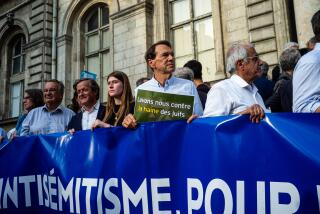Avraham Tory, 92; Diary Told of Nazi Brutality in Lithuania
After German troops rolled into the central Lithuania city of Kovno in June 1941, 30,000 of the cityâs 37,000 Jews who hadnât escaped or been killed were herded into a ghetto. For the next three years, Nazi edicts ruled their lives--and their deaths.
âFrom now on, the Germans declare that any pregnant woman will be killed on the spot,â read one edict.
âJews must pull all wagons themselves, including funeral hearses,â read another.
âThe mother and sister of the hanged Meck [an escapee] must be taken to the Ninth Fort for execution,â read yet another.
By warâs end, all but about 3,000 of Kovnoâs Jews had perished, many in mass executions. But a record of their lives--and deaths--survived to tell their story.
Avraham Tory, a Jewish lawyer who risked his own life by keeping a detailed diary and gathering official Nazi documents that bore witness to what happened to the doomed inhabitants of the Kovno ghetto, died of natural causes Feb. 24 at his home in Tel Aviv. He was 92.
As deputy secretary of the Jewish Council of Elders, which administered the Germansâ rules in the ghetto, Tory was able to record the German decrees and regulations, council deliberations and conversations with Nazi officials in his diary.
âEvery day, I put into writing what my eyes had seen and my ears had heard, and what I had experienced personally,â Tory later wrote.
Working with other council members, he collected Nazi documents, orders, warnings, notices and commands that documented what he wrote in his diary, as well as gathering clandestine photographs and artistâs drawings made by ghetto inhabitants who witnessed Nazi atrocities.
Tory buried all of the documentation in five wooden crates beneath a ghetto apartment house, inserting into each box a note, written in Yiddish:
âWith awe and reverence I am hiding in this crate what I have written, noted and collected with thrill and anxiety, so that it may serve as material evidence--âcorpus delectiâ--accusing testimony when the Day of Judgment comes.â
In case none of Kovnoâs Jews survived the war, Tory instructed a Lithuanian priest to dig up the crates and forward them to the World Zionist Organization.
Couple Escaped Into Countryside
Tory, along with his fiance, managed to escape the ghetto to a hiding place in the countryside in the spring of 1944. They returned to Kovno after Soviet troops occupied the city in August. Tory later smuggled out his diary and the most important documents, which he had buried in a rucksack.
His diary, which is among the most comprehensive surviving official Holocaust diaries, was later used in war-crime deportation hearings against the mayor of Kovno and the SS ergeant who personally directed the mass murder of 9,200 Kovno Jewish men, women and children in what was called the Great Action.
âHe wrote the diary because he wanted to leave evidence so that the world would know what the Germans did,â Toryâs wife, Pnina, said by phone from Tel Aviv on Tuesday. âHe was a very brave man.â
She was equally brave, keeping the latest pages of Toryâs diary in her room and sometimes writing down what he dictated to her.
The Torys, who were married in August 1944 after the liberation of Kovno, had planned to flee Lithuania together. But when Tory received word in February 1945 that he was going to be sent to Siberia, he was forced to immediately leave alone.
His wife and her young daughter from a previous marriage left about three weeks later and joined him in Poland.
After arriving In Israel in 1947, Tory practiced law and became secretary general of the International Assn. of Jewish Lawyers and Jurors.
In 1988, his diary was published in Hebrew. Two years later, it was published in English as âSurviving the Holocaust: The Kovno Ghetto Diary.â
âIt is a painful document,â a Chicago Tribune reviewer wrote, âits pages a collage of retold events, scraps of news, official German directives, firsthand testimonies, whiffs of rumor and terror.â
In one passage of the diary, Tory writes of the morning roll call on Oct. 28, 1941, by Nazi SS Master Sgt. Helmut Rauca, in which he condemned to death entire families with a simple wave or a nod.
âFrom time to time,â Tory wrote, â[he] feasted on a sandwich--wrapped in wax paper lest his bloodstained hands get greasy--or enjoyed a cigarette.â
The next morning, more than 9,000 Jewish men, women and children were gunned down at the edge of a deep pit.
âIn every house a void had been created,â Tory wrote. âThe homes, the furniture, and the belongings of the victims ... seemed to exude the odor of death. Hardly anyone dared touch them or make use of them.â
Emotions Delayed Diaryâs Publishing
Pnina Tory said it took so long for her husbandâs diary to be published âbecause when we got to Israel, it was like fire for him to touch it. He didnât speak about the Holocaust because it was so emotional. He couldnât get over it for a long time.â
Toryâs diary formed the basis for âHidden History of the Kovno Ghetto,â an exhibition at the U.S. Holocaust Memorial Museum in Washington from 1997 to 1999.
âThis community of individuals was essentially destroyed by the Germans,â said museum Director Sara Bloomfield. âBut the effort Tory led and what he did through his diary created a legacy for that community that no longer existed.â
Bloomfield said people in other Jewish ghettos had tried to document things. But Toryâs writing âis certainly important because it is so meticulous. He was a lawyer, so there was precision of language, as if he were preparing evidence for a trial.â
Toryâs diary also inspired a documentary, âKovno Ghetto: A Buried History.â The original diary pages are housed at Yad Vashem in Jerusalem.
Tory was born Avraham Golub in Lazdijai, Lithuania in 1909. After high school, he came to America to study law at the University of Pittsburgh, but returned to Lithuania after his fatherâs death and continued studying law at the University of Kovno. He competed as a gymnast in the first Maccabi Games in Tel Aviv in 1932. As a young attorney, he was active in Zionist politics there.
In addition to his wife, Tory is survived by three daughters who also live in Israel, Shulamit Karbi, Alina Tory and Tzila Magdassi; six grandchildren; and 12 great-grandchildren.
More to Read
Sign up for Essential California
The most important California stories and recommendations in your inbox every morning.
You may occasionally receive promotional content from the Los Angeles Times.










